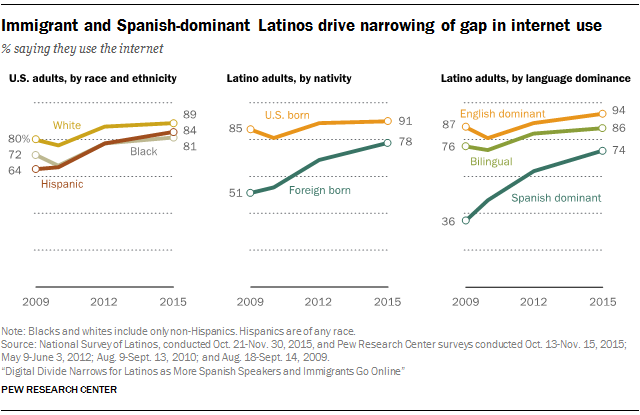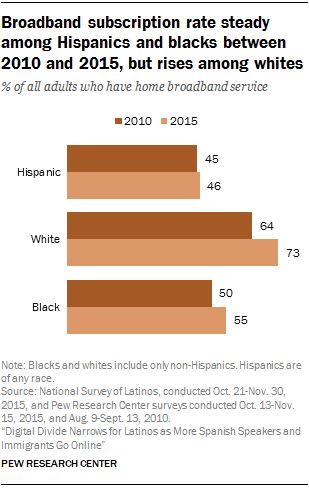The long-standing digital divide in internet use between Latinos and whites is now at its narrowest point since 2009 as immigrant Latinos and Spanish-dominant Latinos make big strides in going online, according to newly released results from Pew Research Center’s 2015 National Survey of Latinos. Meanwhile, broadband use among Latinos is little changed since 2010.
The story of technological adoption among Latinos has long been a unique one. While Latinos have lagged other groups in accessing the internet and having broadband at home, they have been among the most likely to own a smartphone, to live in a household without a landline phone where only a cellphone is available 1 and to access the internet from a mobile device.

Since 2009, the share of Latino adults who report using the internet increased 20 percentage points, up from 64% then to 84% in 2015. Over the same period, internet use among whites grew too, though at a slower rate, moving from 80% to 89%. As a result, the gap in internet use between Latinos and whites declined from 16 percentage points in 2009 to 5 percentage points in 2015.
Big gains in internet use made by immigrant Hispanics and Spanish-dominant Hispanics, two closely linked groups, 2 have been the main drivers in closing this gap. Both groups have long had among the lowest internet use rates among Hispanics – and that is still the case today. Even so, between 2009 and 2015, the share of immigrant Hispanics who use the internet grew from 51% to 78%. And over the same period, the share of Spanish-dominant Hispanics who use the internet about doubled, from 36% to 74%. As a result, the digital divide among Hispanics has also diminished.

As internet use has grown more common among Latinos, the demographic profile of Latino internet users has also changed and is now more representative of the Hispanic adult population. In 2015, immigrant Latinos made up about half (52%) of all adult Latino internet users, up from 44% in 2009. And Spanish-dominant Latinos made up 32% of all Latino internet users in 2015, up from 20% in 2009. In both cases, these shares closely match each group’s share among the adult Latino population overall. (Immigrant Latinos make up 49% of the adult Latino population, and those who are Spanish dominant make up 38% of Latino adults.) Still, the 16% of Hispanics who do not access the internet remain largely foreign born (77%) and Spanish dominant (58%).
Meanwhile, the share of all Hispanic adults who access the internet through a home broadband connection is little changed since 2010. Then, 45% said they accessed the internet through a broadband home connection. Today that share is 46%. Among blacks too there was little change in the share of adults who have broadband access at home – 50% in 2010 and 55% in 2015. Over the same period, that share among whites grew from 64% to 73%.
The Latino survey also shows that among Latino adults, 80% access the internet from a mobile device, similar to the shares among whites (76%) and blacks (77%) in 2015.
More than 55 million Hispanics live in the U.S. today. The nation’s Hispanic population is also one of the country’s fastest growing groups. It is also among the nation’s youngest – nearly half are under the age of 18.
These findings on internet use emerge from the 2015 National Survey of Latinos by Pew Research Center. The survey was conducted in English and Spanish on landline and cellular telephones among a randomly selected, nationally representative sample of 1,500 Latino adults in all 50 states and the District of Columbia. The survey was fielded from Oct. 21 to Nov. 30, 2015, and has a margin of error of plus or minus 3.3 percentage points at the 95% confidence level.
The terms “Latino” and “Hispanic” are used interchangeably in this report.
The terms “whites” and “blacks” are used to refer to single-race, non-Hispanic components of their populations.
“U.S. born” refers to persons who say they were born in the 50 states or the District of Columbia.
“Foreign born” refers to persons who say they were born outside of the United States. Foreign born also refers to those born in Puerto Rico. Although individuals born in Puerto Rico are U.S. citizens by birth, they are included among the foreign born because they are born into a Spanish-dominant culture and because on many points their attitudes, views and beliefs are much closer to Hispanics born abroad than to Hispanics born in the 50 states or the District of Columbia. The terms “foreign born” and “immigrant” are used interchangeably.
Language dominance is a composite measure based on self-described assessments of speaking and reading abilities. “Spanish-dominant” persons are more proficient in Spanish than in English, i.e., they speak and read Spanish “very well” or “pretty well” but rate their ability to speak and read English lower. “Bilingual” refers to persons who are proficient in both English and Spanish. “English-dominant” persons are more proficient in English than in Spanish.
In 2015, an “internet user” is someone who says they use the internet or email at least occasionally and/or says they access the internet on a cellphone, tablet or other mobile handheld device at least occasionally. Prior to 2012, internet users were defined as those who answered “yes” to “Do you use the internet, at least occasionally?” and/or “Do you send or receive email, at least occasionally?” See Methodology for details.
A person is considered to have “home internet” or a “home internet subscription” if they are an internet user and report that they currently subscribe to internet service at home.
A person is considered to have “broadband access” or a “broadband subscription” if they say they currently subscribe to internet service at home and confirm that they subscribe to a higher-speed broadband service. Question wording has changed since 2010; see Topline for details.
A person is considered “smartphone dependent” if they do not have broadband internet access at home but do use a mobile device to access the internet.




